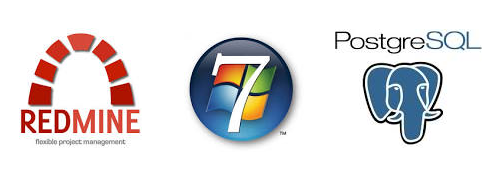Trabla: Redmine & Windows & PostgreSQL : installation tutorial
Solving:
1. Download and install PostgreSQL database, remember to set up password
http://www.enterprisedb.com/products-services-training/pgdownload#windows
(I used Postgres 9.3)
2. Download and install RailsInstaller - tool to install ruby + rails
http://railsinstaller.org/en
( I used railsinstaller-2.2.4.exe )
Installation creates C:\Sites folder where ruby projects shoud be placed.
3. Download Redmine sources
http://www.redmine.org/projects/redmine/wiki/Download
( I used redmine-2.5.2.zip )
4. Create folder C:\Sites\redmine and copy all sources from redmine sources .zip
5. Create empty database and name it "redmine" in PostgreSQL using pgAdmin III
- copy file database.yml.example, and rename copy to database.yml
7. Open database.yml and comment (put # symbol at begining of line ) all configuration,
uncomment postgresql production configuration - fill with database connection data + SAVE
my example, file C:\Sites\redmine\config\database.yml
# Default setup is given for MySQL with ruby1.9. If you're running Redmine
# with MySQL and ruby1.8, replace the adapter name with `mysql`.
# Examples for PostgreSQL, SQLite3 and SQL Server can be found at the end.
# Line indentation must be 2 spaces (no tabs).
#production:
# adapter: mysql2
# database: redmine
# host: localhost
# username: root
# password: ""
# encoding: utf8
#development:
# adapter: mysql2
# database: redmine_development
# host: localhost
# username: root
# password: ""
# encoding: utf8
# Warning: The database defined as "test" will be erased and
# re-generated from your development database when you run "rake".
# Do not set this db to the same as development or production.
#test:
# adapter: mysql2
# database: redmine_test
# host: localhost
# username: root
# password: ""
# encoding: utf8
# PostgreSQL configuration example
production:
adapter: postgresql
database: redmine
host: localhost
username: postgres
password: "pg123" #Put your password here
# SQLite3 configuration example
#production:
# adapter: sqlite3
# database: db/redmine.sqlite3
# SQL Server configuration example
#production:
# adapter: sqlserver
# database: redmine
# host: localhost
# username: jenkins
# password: jenkins
change lines
gem "rmagick", ">= 2.0.0" to # gem "rmagick", ">= 2.0.0"
gem "rake", "~> 10.1.1" to gem "rake", "~> 10.3.2"
+ Save file
9. Start command line with ruby
10. Execute command in cmd
C:\Sites>cd C:\Sites\redmine
C:\Sites\redmine>bundle install
Fetching gem metadata from https://rubygems.org/.........
Resolving dependencies...
.......
Your bundle is complete!
C:\Sites\redmine>set RAILS_ENV=production
C:\Sites\redmine>set REDMINE_LANG=en
C:\Sites\redmine>rake db:migrate
.......
== ChangeChangesetsCommentsLimit: migrated (0.0000s) =========================
C:\Sites\redmine>rake redmine:load_default_data
Default configuration data loaded.
C:\Sites\redmine>rake generate_secret_token
C:\Sites\redmine>ruby script/rails server webrick -e production
=> Booting WEBrick
=> Rails 3.2.19 application starting in production on http://0.0.0.0:3000
=> Call with -d to detach
=> Ctrl-C to shutdown server
[2014-10-12 19:37:52] INFO WEBrick 1.3.1
[2014-10-12 19:37:52] INFO ruby 1.9.3 (2014-02-24) [i386-mingw32]
[2014-10-12 19:37:52] INFO WEBrick::HTTPServer#start: pid=3320 port=3000
11. Open browser and goto http://localhost:3000
sign in as admin using login/password admin/admin













No comments:
Post a Comment